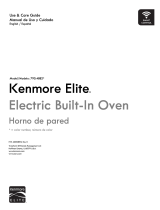
5
IMPORTANT SAFETY INSTRUCTIONS
It is the personal responsibility of the
consumer to have the appropriate outlet
or junction box with the correct, properly
grounded wall receptacle installed by a
qualified electrician. It is the responsibility
and obligation of the consumer to contact
a qualified installer to assure that the
electrical installation is adequate and is
in conformance with all local codes and
ordinances.
See the installation instructions packaged
with this appliance for complete
installation and grounding instructions.
CAUTION
When heating fat or grease, watch
it closely. Grease may catch fire if it
becomes too hot.
Do not use water or flour on grease fires.
Smother fire or flame or use dry chemical
or foam-type extinguisher. Cover the fire
with a pan lid or use baking soda.
Use dry potholders. Moist or damp
potholders on hot surfaces may result in
burns from steam. Do not let potholders
touch hot cooking areas. Do not use
towels or other bulky cloths.
WARNING
Storage In or On Appliance—Flammable
materials should not be stored in an oven
or microwave, near surface burners or
elements, or in the storage or warmer
drawer (if equipped). This includes
paper, plastic, and cloth items, such as
cookbooks, plastic ware, and towels, as
well as flammable liquids. Do not store
explosives, such as aerosol cans, on or
near the appliance.
Do not leave children alone - Children
should not be left alone or unattended in
the area where appliance is in use. They
should never be allowed to sit or stand
on any part of the appliance, including
the storage drawer, lower broiler drawer,
warmer drawer, or lower double oven.
Do not store items of interest to children
in the cabinets above the appliance or
on the backguards of ranges. Children
climbing on or near the appliance to
reach items could be seriously injured.
WARNING
Do not allow children to climb or play
around the appliance. The weight of a
child on an open oven door may cause
the appliance to tip, resulting in serious
burns or other injury. An open drawer
when hot may cause burns.
Stepping, leaning, or sitting on the door
or drawers of this appliance can result in
serious injuries and also cause damage to
the appliance.
Never cover any slots, holes or passages
in the oven bottom or cover and entire
rack with materials such as aluminum
foil. Doing so blocks air flow through the
oven and may cause carbon monoxide
poisoning. Aluminum foil linings may also
trap heat, causing a fire hazard.
Do not use oven or warmer drawer (if
equipped) for storage.
Never use your appliance as a space
heater to heat or warm the room. Doing
so may result in carbon monoxide
poisoning and overheating of the
appliance.
IMPORTANT INSTRUCTIONS FOR
USING THE APPLIANCE




















